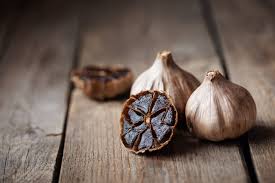If you’ve ever encountered black garlic—perhaps in a gourmet shop, at a farmers’ market, or featured in a chef’s special—you’ve likely paused at its striking, pitch-black appearance. Is this black color simply burnt garlic? Does it indicate mold? Rest assured, black garlic is neither burnt nor moldy. Its deep, dark hue is the result of a fascinating chemical transformation. Let’s explore how this transformation occurs, why it’s safe to eat, and what this means for both flavor and nutrition.
What is Black Garlic?
Black garlic is essentially regular garlic that has been aged under controlled conditions of heat and humidity over several weeks. During this aging—or “fermentation-style” process—garlic’s natural enzymes and sugars interact through something known as the Maillard reaction. This reaction is not unique to black garlic; it’s the same browning process that occurs when toasting bread or searing a steak, but it’s taken to the next level in black garlic.
Why Does it Turn Black?
-
The Maillard Reaction
-
When sugars and amino acids in garlic are exposed to heat over time, they break down and form new molecules that contribute to flavor and color.
-
These dark-hued compounds (called melanoidins) are responsible for turning the garlic cloves a deep brown to black shade.
-
-
Prolonged “Fermentation”
-
Although black garlic is commonly referred to as “fermented,” the process is more akin to a highly controlled, low-temperature roasting that can last anywhere from 2 to 8 weeks.
-
This extended exposure to warmth and humidity intensifies the Maillard reaction, eventually leading to that signature dark appearance.
-
Is It Burnt?
-
No Char or Bitter Flavor: Burnt garlic typically has a sharp, bitter taste. Black garlic, on the other hand, is sweet, tangy, and full of umami.
-
Low, Steady Heat: The temperature range used to create black garlic is typically between 60°C and 90°C (140°F to 194°F). This slow-and-steady method gently transforms the cloves rather than scorching them.
-
Soft and Sticky Texture: When garlic is burnt, it becomes dry and crumbly. Black garlic, in contrast, has a soft, chewy, almost jelly-like texture.
Is It Moldy?
-
No Fungus Involved: Mold thrives in different conditions (usually involving moisture and the presence of mold spores). Black garlic’s transformation is driven by heat-induced chemical reactions, not by fungal growth.
-
Safe to Consume: If black garlic has been produced properly, it is safe to eat and free from the harmful microorganisms that cause mold.
-
Look for Quality: You want to buy from reputable sources or carefully follow guidelines if you’re making black garlic at home (such as using a dedicated fermenter, or a rice cooker/slow cooker with controlled settings). This helps ensure a clean environment free from unwanted contaminants.
Flavor & Nutrition Benefits
-
Flavor Profile
-
Sweet and Savory: Because the strong sulfuric compounds in raw garlic break down over time, black garlic is far milder in taste. It’s often described as having a hint of balsamic vinegar, molasses, or even tamarind.
-
Umami Richness: Black garlic lends a layer of depth to dishes, making it a favorite in gourmet cooking.
-
-
Potential Health Perks
-
Higher Antioxidant Content: Studies suggest that the aging process may boost garlic’s antioxidant levels.
-
Easier Digestibility: Some individuals who find raw garlic tough on the stomach may tolerate black garlic better due to the reduced sulfur content.
-
How to Use Black Garlic
Now that you know it’s neither burnt nor moldy, you may be wondering how to incorporate black garlic into your meals. Some popular options include:
-
Sauces & Dressings: Mash cloves into a paste and whisk into vinaigrettes or sauces.
-
Spreads & Aioli: Combine black garlic with mayonnaise, olive oil, or cream cheese for an elegant dip or sandwich spread.
-
Soups & Stews: Stir chopped black garlic into soups and stews right before serving for a subtle sweet-savory note.
-
Marinades: Smash black garlic into marinades for meat, fish, or roasted vegetables.
Final Thoughts
The inky color of black garlic might raise eyebrows at first glance, but rest assured, it’s a result of a complex—and completely safe—Maillard reaction that transforms both flavor and appearance. Far from being burnt or moldy, black garlic boasts a soft texture, sweetly savory taste, and numerous potential health benefits. If you’re curious, give this culinary gem a try in everything from simple spreads to upscale entrées. You may just discover a new favorite ingredient that brings deep, satisfying flavor without the pungent punch of raw garlic.
What are your thoughts or experiences with black garlic? Share your tips, recipes, or questions in the comments below and join the conversation around this uniquely delicious ingredient!

Comments (0)
No comments yet. Be the first to comment!